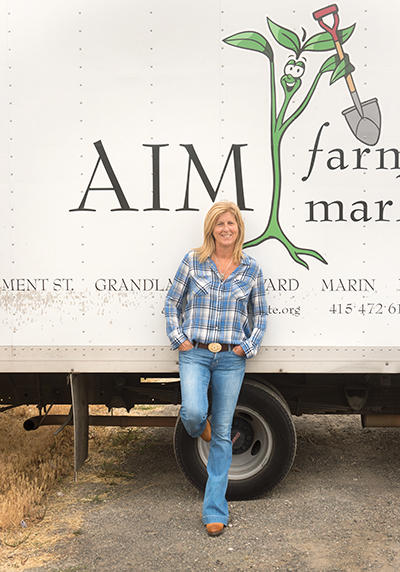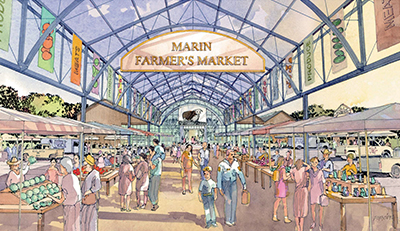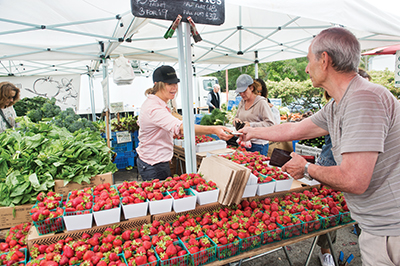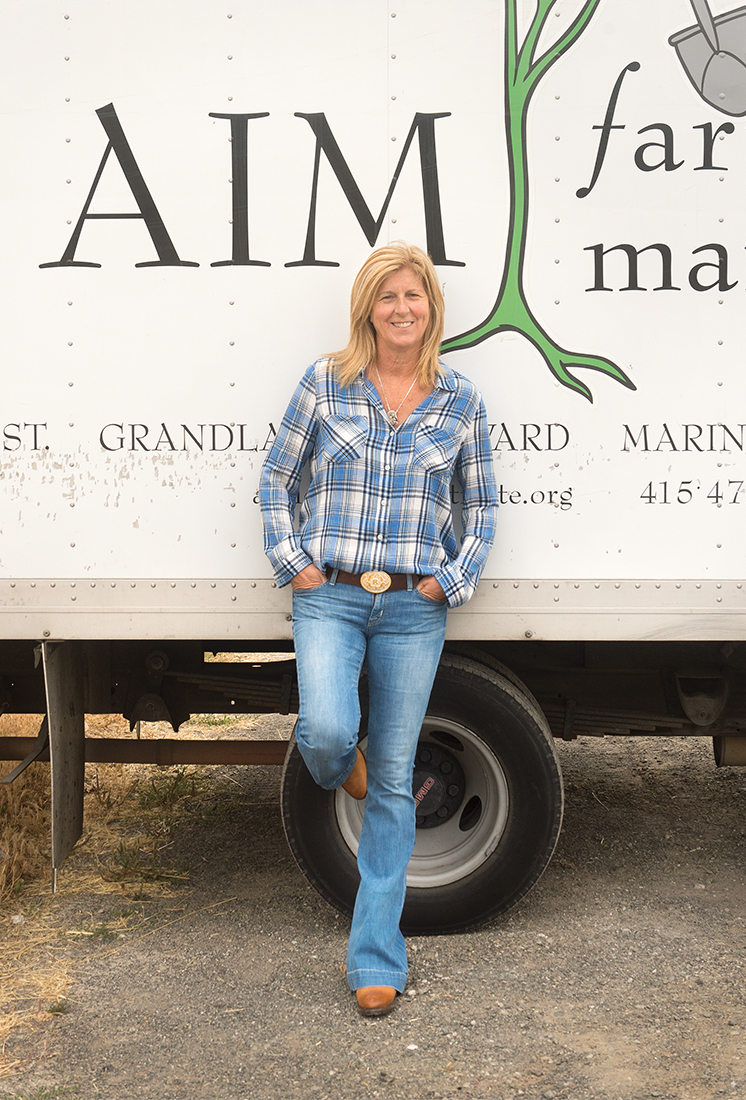
OVER MARIN MAGAZINE’S 11-year history, Brigitte Moran is one of only a few who have been featured twice in Conversation. She first appeared in the July 2010 issue. Why again? Because Moran is now heading up a $20 million project at the Marin County Civic Center that reflects the changing nature of farmers’ markets throughout Marin, California and much of the United States.
Over the past 28 years, Moran has played a key role in the development of Marin’s enormously popular farmers’ markets — those spring, summer and fall congregations that reflect Marin’s healthy, outdoor- and community-oriented lifestyle. She’s the CEO and executive director of the Agricultural Institute of Marin (AIM), a nonprofit that’s been around for seven years and currently manages seven large-scale farmers’ markets: on Clement Street and at Stonestown Galleria in San Francisco; in Oakland, Hayward and Newark; and the Thursday and Sunday morning markets at the Marin County Civic Center.
The Canadian-born Moran, 59, made her way to the U.S. after living in France’s Brittany and Pyrenees regions. She attended Marin Catholic High School, where she met Herb, her husband of 38 years. The couple lives in San Rafael’s Dominican neighborhood, and their three adult children and four grandchildren reside nearby.
Before getting to AIM’s $20 million project, let’s discuss the organization that hopes to make it happen. The Agricultural Institute of Marin is a nonprofit currently operating on a $2.4 million annual budget. Ninety-five percent of our income comes from the $55 we charge for use of each stall at our seven farmers’ markets. We have 16 full-time employees, plus eight part-timers, and we operate 24/7 because markets often take place on weekends. Our offices are on Smith Ranch Road near the San Rafael airport and we have a 15-member board of directors, half of whom are farmers and dairy ranchers, like Lynn Giacomini Stray of Point Reyes Farmstead Cheese, Doug Stonebreaker of Prather Ranch and David Lewis of UC Agricultural Extension, and half are members of Marin’s business and civic community, like Jenny Callaway of Congressman Huffman’s office, Pat Kendall of Kaiser Permanente and Ed Levine of Levine Solutions. Our mission is “to connect and support communities and agriculture.” Two years ago, in anticipation of our capital campaign, we named Vicki Buder as our chief development director, which is similar to the role she previously held for Marin Academy and Marin Country Day School.
In the Marin Magazine Conversation of six years ago, AIM was managing farmers’ markets in San Rafael, Novato, and Fairfax as well as the two at the civic center. Now, in Marin County, AIM manages only Thursday and Sunday morning markets at the civic center. Why the reduced number of markets? When I started working in farmers’ markets 28 years ago, there were 60 regularly operating in California; now there are 850. That’s not because there are that many more farmers who want to market directly to consumers. It’s because there are many more consumers who want a convenient farmers’ market near their home. But farmers who sell direct are simply spreading themselves too thin. And in recent years they’ve been basically telling us, “Look, having all these small markets, spread around like Starbucks, isn’t helping us. Our primary job is farming; let’s have one regional, centralized market where the people can come to us on a regular basis and we can sell at fewer markets and make a decent living at it.” So our board decided to move in that direction, as similar organizations are doing statewide. It isn’t right to have our farmers burn out on the selling side of their way of earning a living — which could very well happen. And, by the way, 25 of the 240 farmers who sell at our civic center farmers’ markets are from West Marin. The others come from throughout Northern and Central California, and they travel a considerable distance to get their products to market.

Courtesy of Backen Gillam Kroeger
This sounds like a lead-in to your major project at Marin County Civic Center. It is. And what’s primarily behind AIM’s project is the need for a feeling of permanence. Our Sunday farmers’ market draws 10,000 people and involves as many as 240 vendors. But our lease with the county allows the county, if need be, to insist that we move to a different location on 30 days’ notice. For instance, we have moved to the Northgate mall for the next five months due to needed road repairs in the area surrounding the civic center. And it’s not easy to move 10,000 people and 240 businesses on short notice, which happens three or four times a year. And a lot of these businesses depend on us for much of their income — and every time we move, we lose a certain percentage of our customers until they can find our new location. There’s also the matter of inclement weather; when it rains or it’s really windy, our current temporary facilities aren’t adequate and our customer base drops by as much as 50 percent. And then, as I mentioned earlier, there’s the desire on the part of farmers, ranchers and dairy people that they have a more centralized location to sell their products.
As of now, where does your project stand? Two years ago, after several months of planning, we were required by a county civic center mandate to go to Marin voters and get permission to build a permanent public market hall and canopies on a five-acre parcel next to the 101 freeway often referred to as the “Christmas tree lot.” The response was 82 percent in favor of approving our request. But it didn’t provide for any funding; it just allowed us permission to build within the civic center area. And since getting voters’ permission we’ve been negotiating a permanent 40-year lease with the County of Marin, with two 10-year options to renew. We’ve developed our building plans and now we’re about to begin the active phase of the fundraising campaign.
What is the cost of the proposed public market hall and canopies? It will cost $20 million; right now we are calling it the Marin Farmers Market. That may change.
Walk us through the proposed Marin Farmers Market. On the five-acre parcel — it’s been mostly a parking lot for many years — we’ll have a public market hall that’s open seven days a week; we’ll have two canopies that cover 90 of our 240 vendors; we’ll have a compound of three buildings that will include a butcher shop run by a rancher, a dairy shop that will be operated by a dairyman, and 28 “day tables” where farmers can sell their produce any day of the week. We’ll also have a restaurant with a demonstration kitchen and a cafe, a working greenhouse, and a children’s play area. For generations, there’ve been public market places like this throughout Europe and Asia; now it’s the future here. But we’ll need the visionaries of Marin to make it happen.

That sounds great, but one might ask why the community should provide a marketplace for farmers and ranchers? They are businesspeople; shouldn’t they be providing their own marketplace? First, I believe this project is for us, the community, not just for the farmers. It’s a place for us to gather as a community around the food from our community. We, Marin, need this, a public place that’s free where we can gather. As for the farmers, honestly, I don’t know how to say this, but our farmers and ranchers are people who for the most part have chosen a lifestyle that really doesn’t make a lot of money. What they do, they do out of a love of the land and a love of the products they produce for us, their community. Their profit margins are very low. This is not the Dole family growing pineapple; it’s Jesse and Moira Kuhn of Marin Roots Farm, who grow organic kale, chicories, and radishes, then sell them at our markets. These folks are good business people, but they aren’t wealthy; they don’t live the Marin lifestyle. And they do need our support, which is one of the reasons the Agricultural Institute of Marin does what it does.
What is your optimum timeline for the $20 million Marin Farmers Market? Our ideal timeline is to raise $10 million by the end of this year. Like similar endeavors involving this amount of money, the first money is the hardest money to raise. And we’ve been silently getting interested, so it looks like we could get that first $10 million by year’s end. Then, assuming we are able to hit this pace, we would be able to break ground by late spring or early summer of 2018. I think a Marin Farmers Market would bring a new and possibly needed energy to the entire Marin County Civic Center. It will be a permanent public farmers’ market close to the freeway and the new SMART station, so it will be easy to reach. And we’ll have a restaurant where people can dine before or after an event at the civic center. Plus, it will be more than a place for people to gather; it will be a place where, with a few hundred dollars, a person can start a business. Sol Food, Novato’s Flour Chylde Bakery, Donna’s Tamales, and Nicasio Cheese all are businesses that started at a Sunday farmers’ market. Our AIM staff is so committed to this project we just bought two dozen lottery tickets and, if we win, we agreed to donate the first $20 million to building the Marin Farmers Market, then split what’s leftover between us. That’s how we feel about this project.


